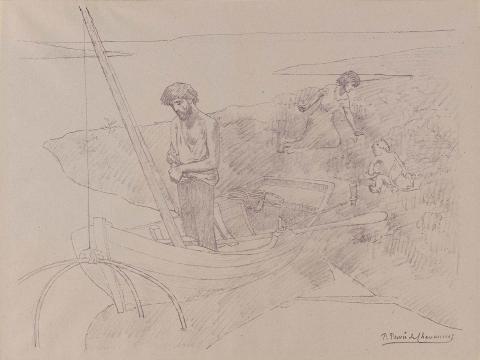EXPANDED LABEL: 1993.006 PUVIS DE CHAVANNES
Published by Ambroise Vollard in L'Album d'Estampes Originales de la Galerie Vollard, Paris, 1897, this lithograph has been printed in purple/mauve ink.
Puvis de Chavannes drew only seven original prints — three etchings, a drypoint and three lithographs — yet his importance in the art history of the period is such that he must be ranked amongst the most influential painter-printmakers of the nineteenth century. Le pauvre pêcheur, which he drew for Vollard's important album of original prints in 1897 and based on the composition of 1881 painting of the same title was his last and his greatest lithograph.
Puvis de Chavannes' art forms the link between the classicism of the early nineteenth century and the impressionists' emphasis on the 'sensation of light'. His inspiration lay not only in the emphasis on emotion prevalent at the end of the nineteenth century but also very much in the calm, ethereal and aloof beauty of the Italian primitive fresco artists, and, at the same time, in a belief in the paramount importance of stylised gesture and pose derived from painters such as Poussin. It is the combination of these qualities which gives Le pauvre pêcheur its masterly and haunting beauty.
Puvis de Chavannes drew only seven original prints — three etchings, a drypoint and three lithographs — yet his importance in the art history of the period is such that he must be ranked amongst the most influential painter-printmakers of the nineteenth century. Le pauvre pêcheur, which he drew for Vollard's important album of original prints in 1897 and based on the composition of 1881 painting of the same title was his last and his greatest lithograph.
Puvis de Chavannes' art forms the link between the classicism of the early nineteenth century and the impressionists' emphasis on the 'sensation of light'. His inspiration lay not only in the emphasis on emotion prevalent at the end of the nineteenth century but also very much in the calm, ethereal and aloof beauty of the Italian primitive fresco artists, and, at the same time, in a belief in the paramount importance of stylised gesture and pose derived from painters such as Poussin. It is the combination of these qualities which gives Le pauvre pêcheur its masterly and haunting beauty.
